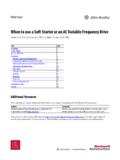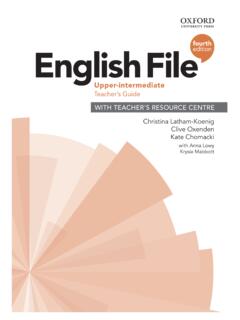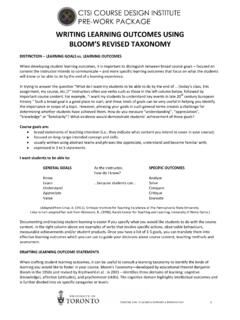Transcription of EXERCISE 3 Population Biology: Life Tables & Theoretical ...
1 EXERCISE 3 Population Biology: life Tables &. Theoretical Populations The purpose of this lab is to introduce the basic principles of Population biology and to allow you to manipulate and explore a few of the most common equations using some simple Mathcad wooksheets. A good introduction of this subject can be found in a general biology text book such as Campbell (1996), while a more complete discussion of pop- ulation biology can be found in an ecology text ( , Begon et al. 1990) or in one of the references listed at the end of this EXERCISE . EXERCISE Objectives: After you have completed this lab, you should be able to: 1. Give de nitions of the terms in bold type.
2 2. Estimate Population size from capture-recapture data. 3. Compare the following sets of terms: semelparous vs. iteroparous life cycles, cohort vs. static life Tables , Type I vs. II vs. III survivorship curves, density dependent vs. density independent Population growth, discrete vs. continuous breeding seasons, divergent vs. dampening oscillation cycles, and time lag vs. generation time in Population models. 4. Calculate lx, dx, qx, R0, Tc, and ex; and estimate r from life table data. 5. Choose the appropriate Theoretical model for predicting growth of a given Population . 6. Calculate Population size at a particular time (Nt+1) when given its size one time unit previous (Nt) and the corre- sponding variables ( , r, K, T, and/or L) of the appropriate model.
3 7. Understand how r, K, T, and L affect Population growth. Population Size A Population is a localized group of individuals of the same species. Sometimes populations have easily de ned boundaries ( , the White-footed Mouse Population of Sandford Natural Area or Hungerford's Crawling Water Beetles of the East Branch Maple River); whereas, in other instances, the boundaries are almost impossible to de ne so they are arbitrarily set by the investigator's convenience ( , Eastern Chipmunks around Holmes Hall). Once the boundaries are set, the next challenge is determining a Population 's size. While it may be most straightforward to actually count all the individuals of a Population , this is rarely done.
4 Usually Population size is estimated by counting all the individuals from a smaller sample area, then extrapolated to the set boundaries. Another common method is capture-recapture. Using this method, a small random sample of the Population is captured, marked, then released to disperse within the general Population . Next a subsequent random sample of the Population is recaptured. The ratio of marked to recap- tured individuals in the second sample can be used to estimate the general poplation's size. Here is a simple formula for estimating Population size (N) from capture recapture data: Total individuals marked in first sample Size of second sample N = ---------------------------------------- ---------------------------------------- ---------------------------------------- ------------------------------------ Number recaptured individuals in second sample Honors Organismal Biology Laboratory 37.
5 Population Biology: life Tables & Theoretical Populations The eld of Population biology is concerned with how a Population 's size changes with time and what factors control those changes, such as birth, mortality, reproductive success, and individual growth. There are many mathematical mod- els and analysis tools that are helpful in understanding Population dynamics. In this lab, we hope to explore and manipu- late some of the fundamental tools available. Semelparous vs Iteroparous life Cycles A Population 's growth potential has much to with how often individual members reproduce. Some species ( , most invertebrates) have only one reproductive event in their lifetime, while others ( , most birds and mammals) are capable of multiple events over an extendended portion of their lives.
6 The former are called semelparous and the latter, iteropa- rous life cycles. There is a large amount of variation, however, within these broad categories. For example, some semelp- arous species have overlapping generations of young so that, at any one time, there may one-, two-, and three-year-old individuals present in the Population . A common form of semelparity in insects of temperate regions is an annual species. In this case, the insect overwinters as an egg or larval resting stage until spring, then grows throughout the warm months and emerges into the reproductive adult. Adults mate and lay eggs that, again, remain dormant throughout the winter.
7 Still other semelparous species complete several generations each summer. It is easy to imagine, then, how the frequency of reproductive events, the number of young produced in each event, and the length of each generation can greatly in uence how fast a Population can grow. life Tables Constructing a life table is often a simple method for keeping track of births, deaths, and reproductive output in a popula- tion of interest. Basically, there are three methods of constructing such a table : 1) the cohort life table follows a group of same-aged individuals from birth (or fertilized eggs) throughout their lives, 2) a static life table is made from data col- lected from all ages at one particular time it assumes the age distribution is stable from generation to generation, and 3).
8 A life table can be made from mortality data collected from a speci ed time period and also assumes a stable age distribu- tion. Note: For organisms that have seperate sexes, life Tables frequently follow only female individuals. Constructing a Cohort (Horizontal) life table for a Semelparous, Annual Organism: Let's begin with a animal that has an annual life cycle, only one breeding season in its life time (it's semelparous), and no overlap between generations. A cohort life table can be constructed from counts of all the individuals of a Population (or estimate the Population size from samples) as it progresses through the growing season. The easiest way to think of this to consider an insect with a determinant number of instars; for example, a typical caddis y with a life history of eight dis- tinct stages (egg, 1st 5th instar larva, pupa, and adult).
9 To make a life table for this simple life history, we need only count (or estimate) the Population size at each life history stage and the number of eggs produced by the adults. The rst column (x) speci es the age classi cation and the second column (ax) gives the number alive at the beginning of each age. From these data we can calculate several life history fea- tures. First, the proportion surviving to each life stage (lx) can be found by dividing the number of indivuals living at the beginning of each age (ax) by the initial number of eggs (a0). Conversely, the proportion of the original cohort dying dur- ing each age (dx) is found by subtracting lx+1 from lx.
10 The age-speci c mortality rate (qx), the fraction of the Population dying at each stage age, is helpful in locating points where mortality is most intense and is calculated by divding dx by lx. The next three columns of the life table are used to assess the Population s reproductive output. The number of eggs pro- duced at each age, is tabulated in the Fx column. The eggs produced per surviving individual at each age (mx), or individ- ual fecundity, is measured as Fx divided by ax. The number eggs produced per original individual at each age (lxmx) is 38 BS/LBS 158H. life Tables an important value to consider in Population studies. By summing lxmx across all ages, the basic reproductive rate (R0).
















